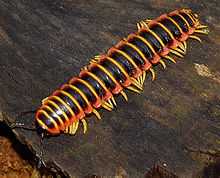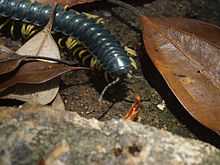Xystodesmidae
| Xystodesmidae | |
|---|---|
 | |
| Apheloria virginiensis | |
| Scientific classification | |
| Kingdom: | Animalia |
| Phylum: | Arthropoda |
| Subphylum: | Myriapoda |
| Class: | Diplopoda |
| Order: | Polydesmida |
| Family: | Xystodesmidae Cook, 1895 |
| Subfamilies | |
|
Melaphinae | |
| Diversity | |
| c. 60 genera, 300+ species | |
| Synonyms | |
|
Fontariidae Attems, 1926 | |
Xystodesmidae is a family of millipedes. Its members often have very small distributional areas, with many species only known from a single locality.[1] They are found across the northern hemisphere, with peak diversity in the Appalachian Mountains, where one-third of the 300 or so species occur.[2] They are particularly abundant in deciduous broadleaf forests in the Mediterranean Basin, Africa, Asia, Central and North America, and Russia.[2] Information on basic taxonomy is scant for this family; for example, it is estimated that the genus Nannaria contains over 200 species, but only 25 have so far been described.[2]
Xystodesmidae contains many colorful and distinctive species, including Apheloria virginiensis of the eastern U.S. and Harpaphe haydeniana of the western U.S. The Sierra luminous millipedes of the genus Motyxia exhibit the only known examples of bioluminescence in the Polydesmida. Species of Apheloria and Brachoria in the Appalachians exhibit Müllerian mimicry, in which unrelated species resemble one another where they co-occur.[3]
The family Xystodesmidae was named by O. F. Cook in 1895, upon the description of Xystodesmus martensii, (previously Polydesmus martensii). Xytodesmidae is placed in the suborder Chelodesmidea within the order Polydesmida (the "flat-backed" or "keeled millipedes"). Xystodemids are characterized by a relatively broad and compact body shape and one or more spines on the second leg-segments (prefemoral spines) in most species.[4]
Classification
The family is divided into three subfamilies: the Melaphinae with around 10 species, the Parafontariinae with a dozen species in a single genus, and the Xystodesminae, with many genera and species.[5]

Subfamily Melaphinae
Macellolophini
- Macellolophus
Melaphini
- Melaphe
- Ochridaphe
Subfamily Parafontariinae
Subfamily Xystodesminae
The subfamily Xystodesminae is subdivided into ten tribes,[5][6] each ending in the suffix "-ini", although taxonomist Richard Hoffman stated in his 1999 checklist: "I am by no means satisfied that this is the definitive arrangement, nor that the tribal divisions of the Xystodesminae are entirely satisfactory either."[5]
Apheloriini Hoffman, 1980
- Apheloria
- Appalachioria
- Brachoria
- Brevigonus
- Cheiropus
- Cleptoria
- Croatania
- Deltotaria
- Dixioria
- Dynoria
- Falloria
- Furcillaria
- Lyrranea
- Prionogonus
- Rudiloria
- Sigmoria
- Stelgipus
Chonaphini Verhoeff, 1941
- Chonaphe
- Metaxycheir
- Montaphe
- Selenocheir
- Semionellus
- Tubaphe
Devilleini Brölemann, 1916
- Devillea
Nannarini Hoffman, 1964
- Nannaria
- Oenomaea
Orophini Hoffman, 1964
_(4032672731).jpg)
- Kiulinga
- Pamelaphe
- Orophe
Pachydesmini Hoffman, 1980
- Dicellarius
- Pachydesmus
- Thrinaxoria
Rhysodesmini Brolemann, 1916
- Boraria
- Cherokia
- Erdelyia
- Gyalostethus
- Pleuroloma
- Rhysodesmus
- Stenodesmus
- Caralinda
- Gonoessa
- Lourdesia
- Parvulodesmus
Sigmocheirini Causey, 1955
- Ochthocelata
- Sigmocheir
Xystocheirini Cook, 1904
- Anombrocheir
- Motyxia
- Parcipromus
- Wamokia
- Xystocheir
Xystodesmini Hoffman, 1980

- Harpaphe
- Isaphe
- Koreoaria
- Levizonus
- Riukiaria
- Thrinaphe
- Xystodesmus
- Yaetakaria
References
- ↑ Richard L. Hoffman (1995). "Laurel Creek Xystodesmid Milliped Sigmoria whiteheadi". In Karen Terwilliger, John R. Tate & Susan L. Woodward. A Guide to Endangered and Threatened Species in Virginia. University of Tennessee Press. p. 58. ISBN 978-0-939923-31-1.
- ↑ 2.0 2.1 2.2 Paul E. Marek & Jason E. Bond (2006). "Phylogenetic systematics of the colorful, cyanide-producing millipedes of Appalachia (Polydesmida, Xystodesmidae, Apheloriini) using a total evidence Bayesian approach". Molecular Phylogenetics and Evolution 41 (3): 704–729. doi:10.1016/j.ympev.2006.05.043. PMID 16876439.
- ↑ Marek, P. E.; Bond, J. E. (2009). "A Mullerian mimicry ring in Appalachian millipedes". Proceedings of the National Academy of Sciences 106 (24): 9755–9760. doi:10.1073/pnas.0810408106. PMC 2700981. PMID 19487663.
- ↑ Hoffman, R L (1978). "The Taxonomic and Nomenclatorial Status of the Milliped Generic Names Parafontaria Verhoeff, Caphonaria Verhoeff, and Japonaria Attems (Polydesmida, Xystodesmidae)". Spixiana (München :Zoologische Staatssammlung München) 1: 215–224.
- ↑ 5.0 5.1 5.2 Hoffman, R. 1999. Checklist of the millipeds of North and Middle America. Virginia Museum of Natural History Special Publications 8, 1–553
- ↑ Marek, P., et al. (2014) A Species Catalog of the Millipede Family Xystodesmidae (Diplopoda: Polydesmida). Special Publication 17. Virginia Museum of Natural History. 140 p.
External links
 Data related to Xystodesmidae at Wikispecies
Data related to Xystodesmidae at Wikispecies Media related to Xystodesmidae at Wikimedia Commons
Media related to Xystodesmidae at Wikimedia Commons